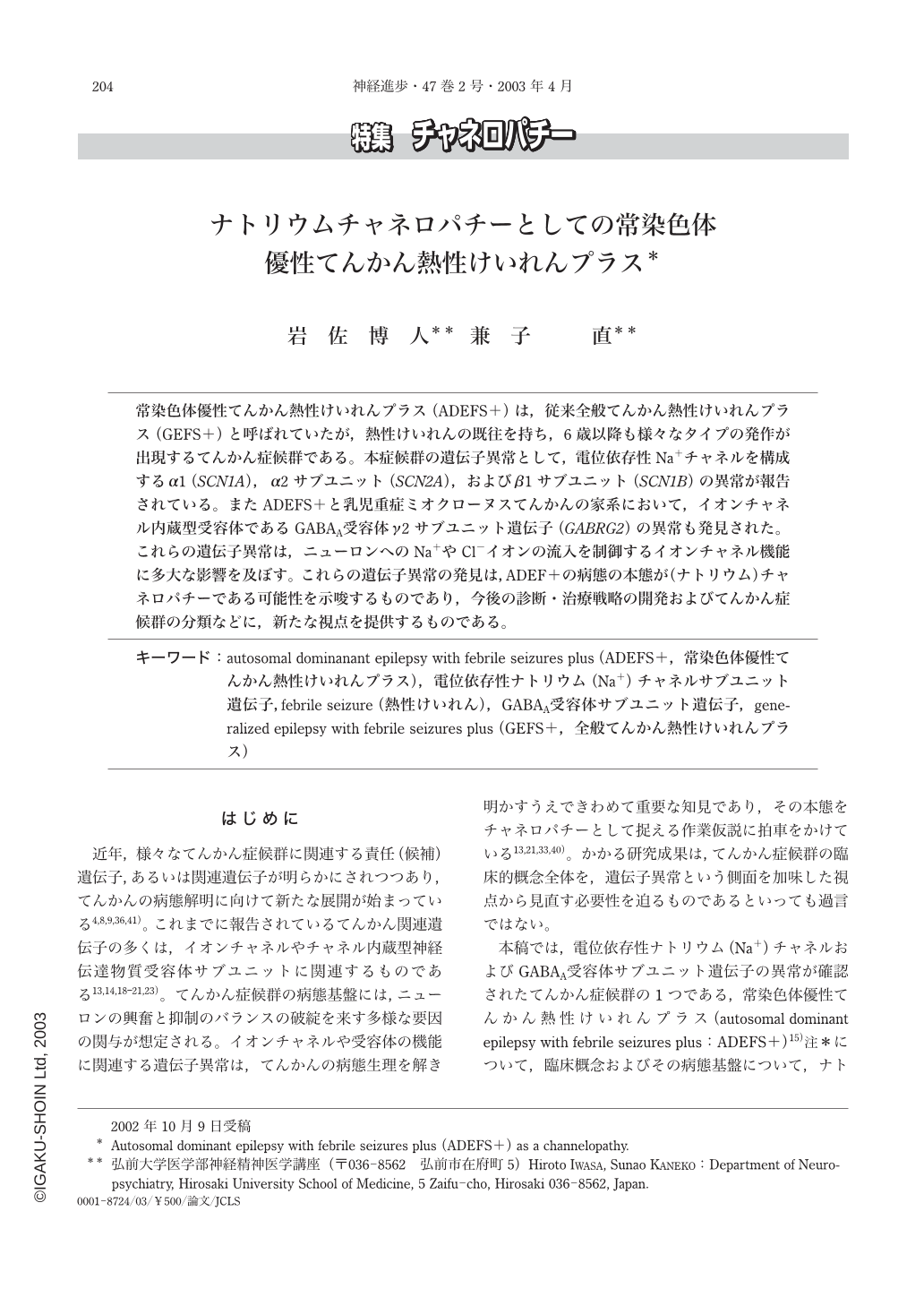Japanese
English
- 有料閲覧
- Abstract 文献概要
- 1ページ目 Look Inside
常染色体優性てんかん熱性けいれんプラス(ADEFS+)は,従来全般てんかん熱性けいれんプラス(GEFS+)と呼ばれていたが,熱性けいれんの既往を持ち,6歳以降も様々なタイプの発作が出現するてんかん症候群である。本症候群の遺伝子異常として,電位依存性Na+チャネルを構成するα1(SCN1A),α2サブユニット(SCN2A),およびβ1サブユニット(SCN1B)の異常が報告されている。またADEFS+と乳児重症ミオクローヌスてんかんの家系において,イオンチャネル内蔵型受容体であるGABAA受容体γ2サブユニット遺伝子(GABRG2)の異常も発見された。これらの遺伝子異常は,ニューロンへのNa+やCl-イオンの流入を制御するイオンチャネル機能に多大な影響を及ぼす。これらの遺伝子異常の発見は,ADEF+の病態の本態が(ナトリウム)チャネロパチーである可能性を示唆するものであり,今後の診断・治療戦略の開発およびてんかん症候群の分類などに,新たな視点を提供するものである。
はじめに
近年,様々なてんかん症候群に関連する責任(候補)遺伝子,あるいは関連遺伝子が明らかにされつつあり,てんかんの病態解明に向けて新たな展開が始まっている4, 8, 9, 36, 41)。これまでに報告されているてんかん関連遺伝子の多くは,イオンチャネルやチャネル内蔵型神経伝達物質受容体サブユニットに関連するものである13, 14, 18-21, 23)。てんかん症候群の病態基盤には,ニューロンの興奮と抑制のバランスの破綻を来す多様な要因の関与が想定される。イオンチャネルや受容体の機能に関連する遺伝子異常は,てんかんの病態生理を解き明かすうえできわめて重要な知見であり,その本態をチャネロパチーとして捉える作業仮説に拍車をかけている13, 21, 33, 40)。かかる研究成果は,てんかん症候群の臨床的概念全体を,遺伝子異常という側面を加味した視点から見直す必要性を迫るものであるといっても過言ではない。
本稿では,電位依存性ナトリウム(Na+)チャネルおよびGABAA受容体サブユニット遺伝子の異常が確認されたてんかん症候群の1つである,常染色体優性てんかん熱性けいれんプラス(autosomal dominant epilepsy with febrile seizures plus:ADEFS+)15)注*について,臨床概念およびその病態基盤について,ナトリウムチャネロパチーという側面を中心に概説する。
Generalized epilepsy with febrile seizures plus(GEFS+)is an important genetic epilepsy syndrome with autosomal dominant inheritance. A small population of patients with febrile seizures(FS)may persist beyond 6 years of age or be associated with afebrile seizures. This clinical subset of FS includes a clinical entity referred to as GEFS+. The most common phenotypes of GEFS+are FS often with afebrile generalized tonic-clonic seizures(FS+). In about one third, additional generalized seizure types occur, such as absences, myoclonic, atonic seizures. However, GEFS+is genetically and clinically heterogeneous, and associated with generalized seizures and partial seizures, such as complex partial seizures, as well. The spectrum of clinical phenotypes should be expanded to include localization-related epilepsies. Therefore, we propose GEFS+be called autosomal dominant epilepsy with febrile seizure plus(ADEFS+).
Three mutations within genes encoding subunits of neuronal voltage-gated Na+ channels have been found in ADEFS+families. A point mutation within the gene SCN1B encoding the β1 subunit of the voltage-gated Na+ channel. Mutations of the voltage-gated Na+ channel α subunit genes, SCN1A and SCN2A were also identified. These mutations interfere the ability of the subunits to modulate Na+ channel-gating kinetics, which in turn cause neuronal hyperexcitability.
Recent studies have provided evidence thatγ2 subunit GABAA receptor is also involved in the pathogenesis of ADEFS+. K289 M mutation in the GABAA receptorγ2 subunit(GABRG2)was identified in a family with a clinical phenotype closely related to ADEFS+. Electrophysiological studies showed that mutations in GABRG2 decrease the diazepam response or GABA response of GABRG2. Since GABAA receptor exerts an inhibitory function in the CNS, dysfunction of GABAA receptor may lead to hyperexcitability of neuron.
Severe myoclonic epilepsy of infancy(SMEI)is an intractable epilepsy of early childhood of unknown etiology. Interestingly, mutations in SCN1A and GABRG2 have been identified in patients with SMEI. These genetic evidences propose that SMEI might be extended spectrum of ADEFS+in phenotypes.
Current evidences in genetic studies illustrate the hypothesis that pathogenesis of some epileptic syndromes are supposed to as a channelopathy. The further progress in epilepsy genetics reveals pathogenesis, clarifies the definition of epileptic syndromes, and generates new treatment strategies including pre-clinical prevention of the disease.

Copyright © 2003, Igaku-Shoin Ltd. All rights reserved.


